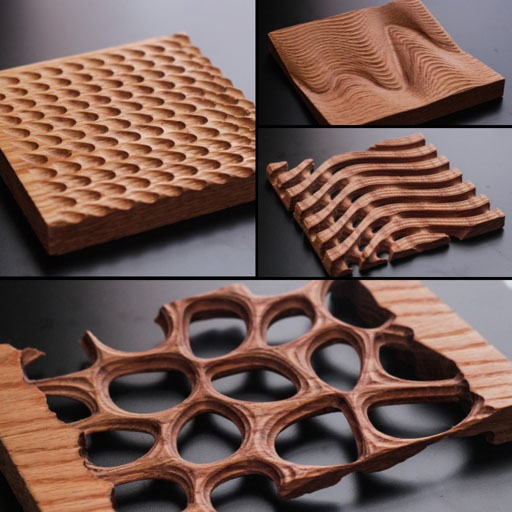Exhibition in honors wing of Gearhart Hall highlights interdisciplinary design
There were no black and white, right or wrong answers in CAM Design and Programming, an interdisciplinary honors colloquium led by artist and mathematics professor Edmund Harriss last spring. Instead, students experimented with computer-aided manufacturing tools to produce objects ranging from a 5-inch by 5-inch exploration of sine curves and wood grain to a jewel-like light box.
These objects and other creative work from the course are showcased in the exhibition Math Craft, currently on display in the Honors College wing of Gearhart Hall.
The course grew out of conversations between Harriss and Rachel Loerts, assistant manager of the Design Shop in the Fay Jones School of Architecture and Design, and Lynn Fitzpatrick, a clinical assistant professor of architecture whose research focuses on digital technologies. Honors students majoring in architecture, engineering, mathematics, computer science, history, English and social work enrolled and found common cause in a stretch goal: to master challenging three-dimensional software modeling tools and push the limits on computer aided manufacturing devices — starting with the computer numerical control (CNC) router located in the basement of Vol Walker Hall.
"The prime thing was for the students to learn to try and take risks," Edmund Harriss said. "It was a good opportunity for them to learn an interesting technology and to play with mathematical ideas."
The hands-on experience with digital fabrication is a major plus for those students with an eye towards careers in design or manufacturing. Corporations are increasingly turning to computer aided manufacturing because the new technology supports flexibility and nimble implementation of design refinements.
"Bespoke, smaller-scale manufacturing opens up a lot of possibilities," Harriss said. "You can easily change a product between runs without increasing manufacturing costs. Apple is making laptop cases created from a single piece on CNC machines now, which is something they can do with this new technology that they couldn't do before."
There's a high learning curve in mastering software like Grasshopper and Rhino, but the greatest challenge may have been the open-ended nature of the course.
"If you give precise instructions, that's all you get back from the students," Harriss said. "That's the whole point of an honors colloquium, to make sure that students have the space to explore their own ideas creatively."
Emily Gentles, an Honors College Fellow and sophomore math major, relished the opportunity to engage in a subject she loves with students in other fields: "It's not every day that I get to talk with a history major about math," she said. The course also gave her an opportunity to flex and develop her mathematical creativity.
"I was the youngest student in the colloquium and that really pushed me to create at a level I wouldn't have achieved on my own," she said. "The most challenging part of the course was translating my ideas into the code, into the wood. It was definitely a growing experience to realize the capacity of my abilities, the machine and the materials."
Lucas Dorrough, who earned his B.S. in computer engineering last May, compared the class projects to solving puzzles.
"With the earlier projects you have to think about what shape this set of equations will make with the router," he said. "With the later projects you have the opposite, you may know what you want the final piece to look like, but then you have to figure out how will that piece be made: 'What path must a 3/8-inch round-point router bit take to make this shape?' This process of problem solving and working between digital plans and the final physical product is something that I have used on other projects since that class."
Math Craft will be on display through the fall semester.
Topics
Contacts
Kendall Curlee, director of communications
Honors College
479-575-2024, kcurlee@uark.edu
